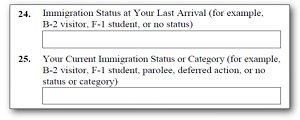Part 2, Item 25 on Form I-765, Application for Employment Authorization, asks for “Your Current Immigration Status or Category.” You may or may not have the same immigration status as when you initially entered the United States. Your current immigration status, which is generally identified by a visa category, describes the basis of your lawful immigration status in the United States.

When you most recently entered the United States, immigration officials likely assigned you an immigration status. This was your status at last entry. Typically, you can find your status at last entry on your nonimmigrant visa or Form I-94. However, if you changed your status since arriving, your visa category may be different. In this case you can likely find your current immigration status on a Form I-797A, Notice of Action.
Mistakes on your Form I-765 can cause costly delays or a denial.
With CitizenPath, you can confidently prepare your Application for Employment Authorization the right way — quickly and affordably. Our attorney-reviewed software simplifies complex forms and provides a personalized checklist of supporting documents for your situation. Start your journey with peace of mind — no credit card or account required to try.Try CitizenPath today and file with confidence >>
Change of Status Example
Change of status is not common. The most common requests are to change to a nonimmigrant student or to a nonimmigrant worker. For example, an individual might enter on an F-1 student visa. Near graduation, the student is offered employment with a company that is willing to sponsor. In this example, the foreign national entered on an F-1 visa but is currently in the United States on an H-1B.
No Status Example
In a similar way, it’s possible that a nonimmigrant doesn’t have any current immigration status. In this case, he or she would have no lawful status in the United States. For example, a person that enters the United States on a B-2 visitor visa and fails to leave before the expiration date on Form I-94 does not have a valid immigration status. (Note: The duration of stay is dictated by the I-94, not the visa.) The person’s current immigration status in this case is “No Status.”

